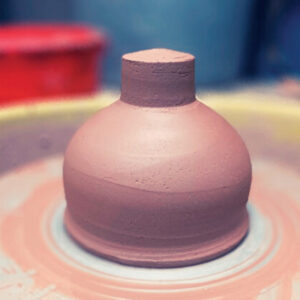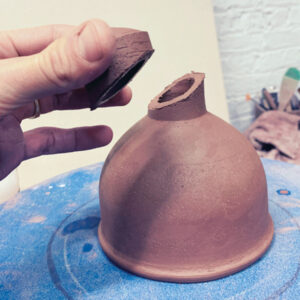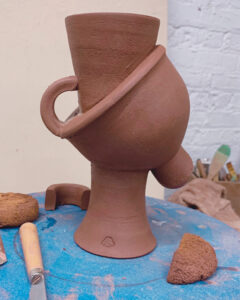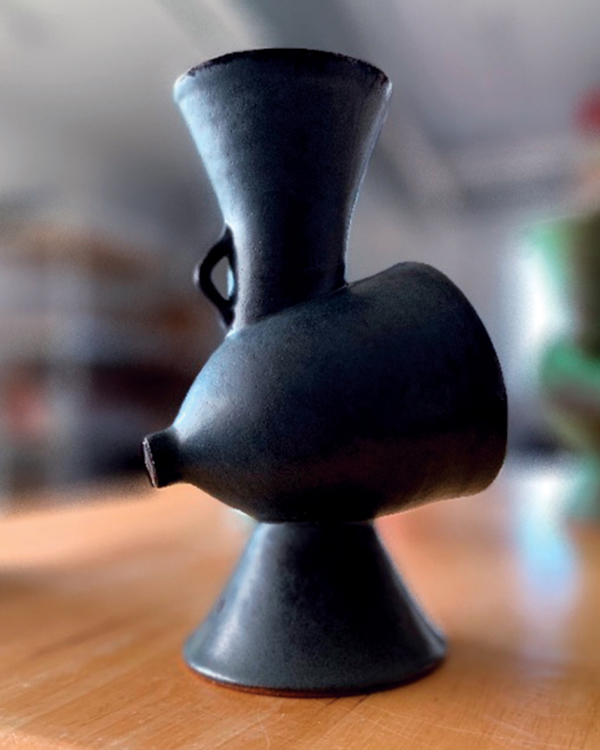In the Midwest around the early 2000s, it appeared that there was a right and a wrong way to be a contemporary potter. The story of being a potter was romanticized as a humble, honest way of life where you worked efficiently to serve the community with thoughtful, functional objects that one could afford to use. For it was the care that was taken while making the object that was the true work of art. Before I knew it, I had bought into this romanticized lifestyle with almost little to no analysis. Deep down, I always knew that working hands-on with clay was something I could not live without; however, my understanding of how to be a potter evolved.
Contemporary ceramics seem to exist simultaneously in the foreground and the background. Interior spaces get a plethora of treatments, ranging from the eclectic bookshelf to the minimal end table in the open-concept layout. I would argue that both have the ability to transform time and space in exciting ways, which is something I have always been interested in. Interior spaces and the objects that we fill them with can have long-lasting power—whether to control the flow of the room or influence how one feels in the space. The objects that we surround ourselves with might say more about us than we have ever imagined.
My Formula for Making Art
Aaron Becker Pottery aka BaBBLEoN = technique vs. form vs. interest vs. ADHD vs. fitting in nowhere vs. career vs. hobby vs. craft vs. art vs. life vs. death vs. peace vs. silence vs. chaos vs. creativity vs. control vs. manipulation vs. intuition vs. intention vs. folk vs. elite vs. awareness vs. destruction vs. longevity vs. sustainability.
Developing a Practice
One of the first things I took note of as a young maker was how every day when I would walk into the studio to create, I often was in a different head space. So like most of us, I’d try to control the day and would stick with a plan. Oftentimes I would end up in a battle against myself to create along the lines of my preconceived intentions. I soon found out that to be successful with clay, to elevate my thinking and creative process, I had to respond to how I was feeling and allow myself to work more intuitively and truly engage with the process. Most importantly, I never stopped asking “what if?” It’s crazy to think that without clay, I might have never figured out how I learn best.
The Journey to the Constructed Vase
Some of my first big inspirations in pottery were Linda Christianson, Shoji Hamada, Clary Illian, Mark Lambert, Warren MacKenzie, Bernard Leach, Gail Nichols, and Sandy Simon—alongside some incredible professors at the University of Minnesota, where I studied with Mark Pharis, Thomas Lane, Christina Schmid, and Tetsuya Yamada. To this day, making handmade objects for everyday people and sharing the ways that handmade utilitarian objects can have a profound impact on one’s life are still part of my mission, but my focus has shifted from object to idea. Nowadays, I often use the complexity of my practice to create a dialog around life and necessity.
Once I got to college, professors started turning me on to different theories of art running parallel to the studio practice. I started realizing that I had been learning pottery from one very specific perspective and wanted to broaden my understanding. I soon became interested in artists like Jun Kaneko, Ken Price, Betty Woodman, Theaster Gates, Hans Coper, Ron Nagle, and Pablo Picasso. I was also drawn to abstract paintings by Arshile Gorky and was reading books by Timothy Morton for the first time. All this would converge in my head when I was kicking that treadle wheel, thinking about art forms and the limitations that particular practices come with.
Exploring the Vase with What if…?
My constructed vase has taken many forms over the years, but originated from a conscious shift toward using the wheel to make parts of art objects rather than a singular piece of pottery.
Now back to the “What if?” question. I would ask myself: What if I made this form out of multiple parts? What if I turned this form on its side? What if I made a vase that was a closed form? What if I concentrated on the similarities between a teapot and vase? What about a vase and a pitcher? What if I made the intentional shift from a focus on utility toward aesthetic preference?
At this time, I was also experimenting with mixing/altering new glazes for the first time. With this change in thinking came a great deal of freedom in my overall approach to my studio practice and more specifically around finishing the surfaces of my work. I was walking a weird line of exploring low-fire glazes from cone 04 up to cone 2.
Using the wheel as my primary forming tool, I would create a ware board full of different thrown parts that I would later problem solve through that act of constructing. This consisted of a lot of closing one eye and standing back, moving parts all around to see what composition I could come up with that would be the most pleasing. Then I would ask myself, what is the most balanced, the most unbalanced, the most top heavy, the most bottom heavy, and so on. However, the biggest shift came from the idea of vases projecting flowers out into the world differently. Questions that probed the possibilities included: What if the flowers were falling out of the vase or shot out of the vase like a cannon? What if the flowers could create a different type of balance than the ones we often see in traditional upright, linear vase forms? Or, what if we were all vessels to show off other peoples flowers? This last question seemed to be the most interesting and aligned more with my life philosophy. These side-by-side analogies kept generating questions. Can we be a vase for our own flowers? Are we all just different vessels being filled with different things? I enjoy the relationship of people and pots, or more importantly people as vessels. I started thinking about how we give people flowers alongside how we project ourselves out into the world and how we project to others.
Constructing the Vase
Before I sit down at the wheel, I often visualize 5–8 vases in a row with evolving midsections. It’s almost like layering all the possible compositions/cuts and visualizing them all at once. I tend to focus on questions like a desired finished height, or the proportions. Oftentimes, the preferred flower type will dictate a long- or short-neck vase. It is exciting seeing how simple changes would better accommodate traditional or abstract flower arrangements.
I always begin by throwing a variation of a closed form for the body or bulk of the composition (1). The closed form started off as a visual representation of a closed mind, and the first few looked like grain silos (2, 3). So, being from the Midwest, it was a way of turning tradition on its head. It was a revolt against how boxed in I felt at the time. This was the first time where I was really converging conceptual ideas into a utilitarian vase.
I then make different cylinders, rings, and necks/tops of vases (4–7). To finish the form, I play with different ideas of low, humble feet near or on the ground. However, I found that lengthening the bottom portion of these vases can almost put them on a pedestal. I have enjoyed making the majority of my decisions in a loosely imagined daydream, allowing my hands to be free from worry and just work (8, 9). To be completely honest, these forms are like my life and quest for knowledge—always in flux.
Glazing
When it comes to glazing these vessels, I have tried many solutions over the years. I often tried to make them more sculptural by adding another layer of information, like textures or detailed brushwork, but the vases became too busy, or I would get cornered into one specific narrative with my illustrations.
All the pots get a single application of glaze on the surface. This choice unifies the form and allows the vases to stand strong in their oddities of varied shapes and size. I like to brush on the glazes to control the amount of surface variation on the final form. The pots are fired to cone 04 with a 20 minute hold at cone 02.












Article originally posted on CermamicArtsNetwork.org.


“My constructed vase has taken many forms over the years, but originated from a conscious shift toward using the wheel to make parts of art objects rather than a singular piece of pottery. ”
Doing big things my guy. Beautiful to see your journey express itself not only through pottery, but through other forms as well. Keep writing and keep creating <3.
Somebody essentially help to make significantly articles I’d state. This is the first time I frequented your web page and up to now? I surprised with the research you made to make this actual post incredible. Fantastic job!
My brother suggested I might like this website He was totally right This post actually made my day You cannt imagine just how much time I had spent for this information Thanks
You really make it seem really easy with
your presentation however I to find this topic to be actually one thing that I believe I might never understand.
It kind of feels too complex and very wide for me.
I am taking a look forward for your next post, I
will try to get the hold of it! Escape rooms hub
I was reading some of your articles on this site
and I conceive this web site is really instructive! Keep putting up..
Muy buena información. Pienso que es un tema clave para seguir explorando.
I am extremely inspired with your writing talents as smartly as with the
format in your weblog. Is this a paid subject or did you customize
it yourself? Anyway keep up the excellent high quality writing, it’s
rare to see a great blog like this one these days.
Lemlist!